《跨文化交际》常见问题解答
- 格式:doc
- 大小:31.50 KB
- 文档页数:4

跨文化交际的问题与解决研究随着全球化的加速和国际交往的不断加深,跨文化交际问题已然成为我们生活中不可避免的一部分。
在跨文化交际中,我们往往会面临各种挑战和问题,比如语言障碍、文化差异、沟通方式不同等等。
为了更好地解决这些问题,我们需要深入研究跨文化交际的本质和特点,并探索有效的解决方法。
一、跨文化交际的本质和特点跨文化交际是指在不同文化背景下的交际活动,涉及到的人群、语言、文化等都存在较大的差异。
跨文化交际的本质是不同文化之间的交流和互动。
在跨文化交际过程中,我们需要通过语言、视觉、肢体语言等方式进行沟通,同时理解和尊重不同文化之间的差异和特点,以达到和谐共处和合作。
跨文化交际的特点主要有以下几个方面:1. 多样性:不同国家和地区之间存在着各种语言、文化和传统,人们在跨文化交际中需要面对多元的差异性和复杂性。
2. 动态性:跨文化交际不是一成不变的,随着社会、历史和经济等因素的变化,跨文化交际需要不断地适应和调整。
3. 矛盾性:不同文化之间的差异和冲突是不可避免的,跨文化交际需要协调和解决各种矛盾问题。
二、跨文化交际中常见的问题在跨文化交际中,我们需要面对各种各样的问题,下面列举了一些常见的问题:1. 语言障碍:不同国家和地区之间存在着各种语言,语言障碍是跨文化交际中最基本的问题。
2. 文化差异:不同文化之间存在着种种不同,如礼仪、宗教、道德等方面的差异,这些差异可能会导致误解或矛盾。
3. 沟通方式不同:不同文化之间的沟通方式和表达方式也存在差异,如在中国,说话时一般比较委婉、含蓄,而在美国,人们则更注重直接表达和说话技巧。
4. 价值观不同:不同文化之间的价值观存在着差异,如在西方国家,人们更注重个人的自由和权利,而在亚洲国家,人们则更重视集体意识和家庭观念。
三、跨文化交际的解决方法如何在跨文化交际中解决上述问题,使得交流和合作更加顺利呢?以下几点可以作为参考:1. 学习对方的语言和文化:学习对方的语言和文化是解决跨文化交际问题的基本方法,能够更好地理解对方的观念和行为方式。
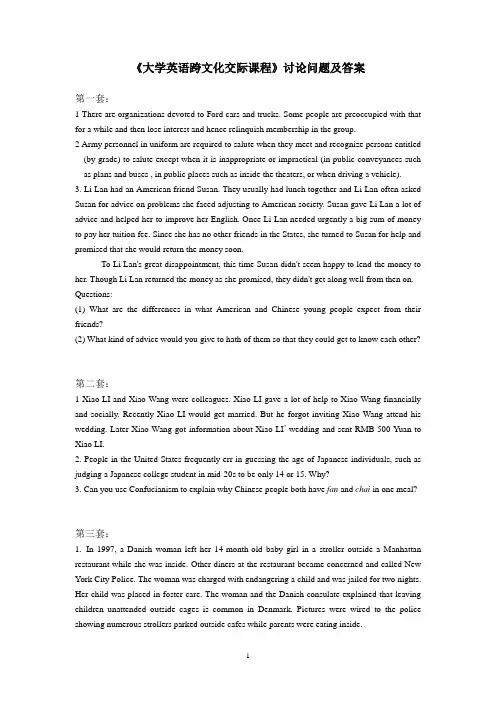
《大学英语跨文化交际课程》讨论问题及答案第一套:1 There are organizations devoted to Ford cars and trucks. Some people are preoccupied with that for a while and then lose interest and hence relinquish membership in the group.2 Army personnel in uniform are required to salute when they meet and recognize persons entitled (by grade) to salute except when it is inappropriate or impractical (in public conveyances such as plans and buses , in public places such as inside the theaters, or when driving a vehicle).3. Li Lan had an American friend Susan. They usually had lunch together and Li Lan often asked Susan for advice on problems she faced adjusting to American society. Susan gave Li Lan a lot of advice and helped her to improve her English. Once Li Lan needed urgently a big sum of money to pay her tuition fee. Since she has no other friends in the States, she turned to Susan for help and promised that she would return the money soon.To Li Lan's great disappointment, this time Susan didn't seem happy to lend the money to her. Though Li Lan returned the money as she promised, they didn't get along well from then on. Questions:(1) What are the differences in what American and Chinese young people expect from their friends?(2) What kind of advice would you give to hath of them so that they could get to know each other?第二套:1 Xiao LI and Xiao Wang were colleagues. Xiao LI gave a lot of help to Xiao Wang financially and socially. Recently Xiao LI would get married. But he forgot inviting Xiao Wang attend his wedding. Later Xiao Wang got information about Xiao LI’ wedding and sent RMB 500 Yuan to Xiao LI.2. People in the United States frequently err in guessing the age of Japanese individuals, such as judging a Japanese college student in mid-20s to be only 14 or 15. Why?3. Can you use Confucianism to explain why Chinese people both have fan and chai in one meal?第三套:1.In 1997, a Danish woman left her 14-month-old baby girl in a stroller outside a Manhattan restaurant while she was inside. Other diners at the restaurant became concerned and called New York City Police. The woman was charged with endangering a child and was jailed for two nights. Her child was placed in foster care. The woman and the Danish consulate explained that leaving children unattended outside cages is common in Denmark. Pictures were wired to the police showing numerous strollers parked outside cafes while parents were eating inside.2. Assume that global warming is a fact, and, as a result, assume that summers in the United States average 43℃(109℉). It would be logical to make adjustments: Rather than air condition building all day, you might close schools and businesses in the afternoons to conserve energy. Such adjustments would make sense. Why then do some people attribute sensible midday siestas in hot climates to laziness?第四套:1 Sometimes parents will say to their children “ We don’t associate with people like that.” Or “be careful when you’re with them.”2. A classic psychology study in the 1970s had two groups of undergraduates read stories about a woman. The stories were identical, except that one had the sentence “ Betty is now a lesbian.” On a test one week later, individuals in the group that had read that Betty is a lesbian were much more likely than individuals in the other group to recall having read that Betty never dated men. In fact, the story that both groups had read stated that Betty dated men occasionally.3. In India, there are elaborate rules about how closely members of each caste may approach other castes, and Arabs of the same sex do stand much closer than North Americans. North Americans in an elevator maintain personal space if the physical space permits it. An Arab entering an elevator may stand right next to another person and be touching even though no one else is in the elevator.4. In Thailand and Laos, it is rude for a stranger or acquaintance to touch a child on the top of the head because the head is regarded as the home of the spirit or soul. It is believed that a child’s spirit or soul is not strong enough to be touched and has tendency to become ill if patted.第五套:1 Chinese students can not make good use of the following phrases which are comprised of only simple words, such as read between the lines,hold water, kick the bucket.2 During World WarⅡ, the Allies had issued the Potsdam Ultimatum demanding the surrender of the Japanese military to end the war. Prime Minister Suzuki said, “The government does not see much value in it. All we have to do is mokusatsu it.” But the word mokusatsu can mean anything from “ignore” to “treat with silent contempt.” The Allies took it as the most offensive meaning. 3. The US and China have continual conflicts on human rights. Both accused the other side that they have human rights abuses. Despite of great efforts in resolving the differences, the problem still exists.第六套:1 A student from Colombia may study in the United States and earn a Ph.D., teach at adistinguished university, and publish important books, but when he returns to visit Colombia, people to whom he is introduced will want to know to whom he is related. Colombians want to know who his family is because that places him in society much more so than any of his accomplishments in the United States.2.In Germany, there is a society that relies on rules, laws and regulations. Students expect their teachers to be experts who have all the answers. In the workplace, there is an inner need to work hard. Germany wants to reduce its risks to the minimum and proceed with changes step by step. 3.Employment decisions cannot be made on the basis of age, ancestry or ethnicity, disability, marital or parental status, race, religion, or sex.4.Time clocks are everywhere: In homes, cars, work sites, on wrists, at organized play sites. Many people report feeling uncomfortable not knowing the time. Perhaps only camping in the woods---without a radio and clocks--- can one be free of time awareness in the United States.第七套:1 Japanese advertising reflects Confucian and collectivistic values. Concepts of face and harmony relate to an indirect communication style, It is said that the goal of Japanese advertising is to win the trust and respect of the consumer; Taiwan advertising generally links the product to the consumer’s traditional Chinese values, such as family relations and respect for authority. 2.Disney’s $4.4 billion Euro Disney opened outside Paris in April 1992, later the park was losing $1 million a day. Disney was forced to take some measures; it had discounted its own value as a U.S. icon. It has now become the most popular tourist attraction in France.3.Post-World War ⅡJapanese products of the time were popularly known as “junk”, so General Douglas MacArthur asked Washington to send someone to help conduct a national census and assess Japan’s ability to rebuild. Dr. W. Edward Deming, a relatively unknown statistician for the U.S. government, was sent. Deming stressed achieving uniform results during production rather than through inspection at the end of the production line.Later, Dr. Joseph Juran lectured in Japan on extending quality from just manufacturing to the entire process from product design to product delivery to the customer. This and other efforts had by 1970s resulted in top-quality cameras, electronics, etc.Later, companies such as Lockheed and Honeywell started similar pilot programs, but the program did not fit in well with the dominant U.S value of individualism.Questions:(1)analyze the role of General MacArthur and Dr. Deming in the model?(2)why did the program did not have the same impact they had in Japan?第八套:1 When a person arrives in a new country, everything seems so new and exciting.2 An international student in a U.S. grocery may be asked, “Paper or plastic?” The student knows what paper is and what plastic is, but doesn’t understand the question.3 The practice of cao gio —rubbing coins with hot balm oil on the chest and back of a sick person —led to the jailing of one father, who subsequently committed suicide.4 The defendants, who were members of the Amish faith, refused to send their children, aged 14 and 15, to public school after the children had completed the eighth grade.第九套:1.Budweiser advertised to three regional subgroups: In California, Texas, and the Southwest, advertisements aimed at Spanish-speakers of Mexican heritage featured cowboys and cactus; In the Northeast, advertisements aimed at Puerto Ricans featured cityscapes and salsa music; and the Florida, advertisements aimed at Cubans featured palm trees, cigars, and bananas. Each advertisement featured differently accented Spanish and national-origin-appropriate music.2. The Nielsen study of Hispanic television viewing showed that Hispanics watch very differently TV shows than the general public does. Adults prefer Univision and Telemundo to the English-language network shows 3 to 1. Of English-language shows, only 1 in 4 of the top 10 shows shows preferred by the general public rated in the top 10 for Hispanics.3. Leslie Zhueng was a famous singer and movie star in Hong Kong. His fame and popularity brought a lot wealth to him. And he had a boyfriend, Mr. Tang.4. Southwest is the only major airline in the U.S. that has been profitable in each of the last five years. It has the youngest fleet, the best safety record, and awards for customer service. Like all the better-performing companies, Southwest Airlines has a well-defined set of values that helps the company to survive in those difficult times.第十套:1.A White male department manager posted training opportunities as required but strongly encouraged other White heterosexual man in the department to sign up. He never mentioned them to any women, ethnic group members, or lesbians and gay men.2.A new Spanish immigrant to the United States may have a strong feeling of discomfort, fear, or insecurity when he enters into the Unites States.参考答案第一套:1 This case can reflect one of features of subgroup ---Temporality. Membership in somegroup is temporary; that is, members may participate for a time and later become inactive or separate from it altogether.2 Every culture and subgroup provides its members with rules of behavior, or what are called rules and norms. Indeed, the extent to which a person is a member of a culture is often gauged by his or her adherence to norms. In communication studies, it is assumed that behavior governed by socially agreed-on norms or by one’s individual guidelines for behavior. Army personnel belongs to subgroups, therefore it has its own rules and norms . Salute is one of them.3.1)Li Lan asked to borrow money from her American friend Susan, which is rarely part of Western friendship. Li Lan and Susan have different expectations of friendship.2) In the West, people prefer to be independent and equal rather than dependent, so they don't feel comfortable in a relationship in which one person gives more and the other person is dependent on what is given. Among friends they mostly provide emotional support to each other and spend time together, so they rarely borrow or lend money to each other. They would ask for a loan from the bank rather than from their friends. While in China, people expect their friends to Be loyal to each other, and they even take risks for their friends. So they would give not only emotional support to each other but also concrete help to each other, such as helping to find a job, solving a problem, or even giving money to help one out over along period of time. So when a friend is in need, the first person he or she wants to ask for help is naturally his/her friend.3) As an American, Susan would like to help her Chinese friend Li Lan. But she didn't expect Li Lan would ask for money, which goes against the principle of independence and equality. While as a Chinese, Li Lan regarded Susan as her good friend, and she considered it natural to ask to borrow money from Susan when she needed the money urgently.)4) Li Lan first should try to get to know American culture as much as possible. She may also need to have a discussion with Susan about the different ways of friendship in both cultures. If possible, she could try to ask for a loan from a bank.5) Susan should also try to learn to understand Chinese culture. She could also have a discussion with Li Lan about the different expectation of friendship in both cultures. If she could understand the Chinese ways, she might help Li Lan out financially by lending her the money.第二套:1.In Chinese culture influenced by Confucianism, if someone does a favor for you, you should return the favor to them. This is very common for Chinese people .In the philosophy ofConfucianism Reciprocity are the base of relationships. Gratitude and indebtedness are important parts of Chinese culture. If a person feels uneasy to be indebted of someone , payback is necessary to achieve balance in the relationship.2.Interpretation refers to attaching meaning to sense data. The same situation can be interpreted quite differently by diverse people. The effect of culture is great. Applying these same cues to someone from another culture may not work. So people in the United States frequently err in guessing the age of Japanese individuals, such as judging a Japanese college student in mid-20s to be only 14 or 15.3.The distinctive process of preparing Chinese cuisine is based on Confucius and his philosophy fan and chai of balance. There is a division between fan, Chinese for grains and other starch foods, and chai vegetable and meat dishes. A balanced meal must have an appropriate amount of fan and chai.第三套:1. This case reflects one of the barriers to the effective intercultural communication----assuming similarity instead of difference. The Danish woman had assumed that Copenhagen is similar to New York, that what is commonly done in Copenhagen is also commonly done in New York.2. The reason why some people attribute sensible midday siestas in hot climates to laziness is that they negatively judge aspects of another culture by the standards of one’s own culture. This case reflects one of the barriers----- ethnocentrism.第四套:1 This case can reflect one of reasons for the persistence of prejudice--- socialization. Prejudicesare learned. Many prejudices are passed on from parents to children.2 The group’s stereotype of a lesbian influenced what they recalled having read. Stereotypes also impede communication when they cause us to assume that a widely held belief is true of any one individual. For example, if a group is stereotyped as dishonest, that does not mean that any on individual in that group is dishonest.3.This case can reflect one nonverbal communication category ---Proxemics. How much space we each want between ourselves and others depends on our cultural learning, our upbringing in our families, the specific situation, and our relationship with the people to whom we’re talking. The physical distance we want between ourselves and others does vary from culture to culture. 4. This case reflects one nonverbal communication category---Haptics. Haptics is communicating by touch. Touch can communicate a wide variety of messages. The meaning of touch depends on the kind of touch (hard, gentle, etc.) and the context. Different societies have different norms fortouching. These rules determine the kinds of touching that are appropriate for certain situations and social relationships.第五套:1. This case can reflect the lack of idiomatic equivalence between two cultures is a barrier to successful translation. 2 Language that are different often lack words that are directly translatable. This leads to the lack of vocabulary equivalence, which is one of the causes of translation problems.第六套:1.This case can reflect the differences between individualist culture and collectivist culture. Cultures characterized by collectivism emphasize relationships among people to a greater degree. Collectivist cultures stress interdependent activities and suppressing individual aims for the group’s welfare.2 This case can reflect the feature of high uncertainty avoidance cultures. Cultures strong in uncertainty avoidance are active, aggressive, emotional, compulsive, security seeking, and intolerant.3.Equality is an important cultural myth in the United States. The U.S. legal system promises equal treatment. It is popularly said that everyone should be treated equally. Everyone should have the same opportunity to work hard and succeed.4.In the United States, time is viewed as a commodity. Such phrases as “time is money,”“how much time do you have?”“ don’t waste time,” and “budget your time” are common. When time is thought of as a commodity, one needs to be constantly aware of it.第七套:1 This case can reflect the key to the diffusion and convergence processes across cultures isadaptation of the message to the receiving cultural. The key is to adapt to the local cultural, localize thinking, localize the product, and localize the marketing strategy.2 The introduction or rejection of an innovation has consequences for a society. All the parts of a culture are interrelated. One change can have repercussions in other areas. Not all of those consequences can be anticipated.3.(1) In this example, General Mac Arthur provided the opinion leadership and Dr. Deming was the change agent.(2) Because quality circles did not fit in well with the dominant U.S value of individualism.第八套:1. It’s the first stage of culture shock: “honeymoon stage” or initial euphoria.2. It’s the second stage of culture shock: disintegration of familiar cues and irritation hostility with the differences experienced in the new culture.3.This is one example of the differences between U.S. and Vietnamese cultures. Misunderstandings about folk medicine practiced by Vietnamese refugees have led to charges of child abuse and at least one suicide. Understanding of the cultural differences could help prevent further unfortunate incidents like this.4. After the eighth grade, Amish children may continue education at home on the farm to learn the practical skills of providing for family and community. Further education is discouraged as it instills feelings of superiority that would lead to placing the needs of the self over those of the community. So this example shows that the Amish people live separately from the dominant culture and maintain their own cultural identity.第九套:1 From these advertisements, we can discover that marketing to the Hispanic community involveds not only language and images that mean something to the buyer but also cultural traditions and valures. And the larger advertisers have learned that the Hispanic culture is not one culture but many.2. This study showed that Spanish language was the most important factor in reaching the Hispanic audience.3. Leslie Zhueng belonged to different subgroups and had various subgroup identities. According to region, he was a Hong Kong resident. According to occupation, he was a singer and actor. According to economic status, he was rich. And according to sexual orientation, he was a gay.4. Cooperate culture is a form of subgroup culture. Cooperate culture provides members in the organization a set of values and patterns of behavior. Like cultures, corporate culture has its own heroes, rituals, media and values.第十套:1. In the heterosexual White male dominant culture in the United States, women, ethnic group members, minorities groups and homosexual people often experience discrimination in employment activities.2. A new immigrant may experience culture shock when he enters into the United States. Cultural shock is psychological reaction, which naturally happens when a person enters into a new culture. There are certain syndromes at each period of culture shock.。

跨文化沟通的问题与对策随着全球化的进程不断加深,跨文化沟通变得越来越重要。
在国际业务、教育交流、旅游等领域,人们需要与来自不同文化背景的人进行交流。
跨文化沟通涉及到许多因素,包括语言、价值观、行为习惯、信仰等,如果不了解这些因素,沟通可能会出现误解。
为了避免跨文化沟通的问题,本文将介绍一些常见的问题和对策。
问题一:语言障碍语言障碍是跨文化沟通中最常见的问题之一。
即使两种语言在口音和结构上相似,仍然存在歧义和误解的可能性。
此外,即使使用同一种语言,文化差异仍然可能导致误解。
对策一:学习目标语言解决语言障碍最直接的办法是学习目标语言。
了解目标语言的基础语法、词汇和语境可以帮助人们更有效地进行口头和书面交流。
在实践中,人们应该尽可能使用目标语言,与使用自己的语言相比,这样做将更好地锻炼语言能力。
此外,了解目标文化的价值观和信仰也是了解目标语言的重要方面,这将更有助于人们的跨文化交流。
问题二:文化差异即使使用相同的语言,文化差异仍然可能导致误解。
不同文化有不同的价值观、行为习惯和信仰,这些因素会影响人们的思维和行为,导致交流上的误解。
对策二:了解文化差异为了避免文化差异造成的误解,人们需要了解不同文化之间的差异。
了解目标文化的价值观、行为准则和信仰可以帮助人们更好地理解对方的思维和行为。
人们还可以查阅相关文献、参加文化培训或与来自不同文化背景的人进行交流。
了解文化差异是跨文化沟通中至关重要的一环,它有助于推动双方的相互理解。
问题三:非语言交流除了语言交流以外,跨文化沟通还包括其他形式的交流,例如面部表情、手势、姿势和身体接触。
对策三:学习非语言交流技巧了解非语言交流技能同样重要,因为它们可以很好地指示语言以外的含义。
人们可以通过参加讲习班学习姿势、手势和面部表情等技能,这些技能有助于人们更好地理解对方的表达意图。
此外,在进行非语言交流时,人们还应注意不同文化之间可能存在的差异,以避免产生误解。
问题四:技术障碍当人们进行跨文化沟通时,技术障碍也可能成为问题。

跨文化交际案例分析题及答案案例描述在跨国公司A的一个国际会议上,来自不同国家的员工们需要共同讨论一个重要项目。
会议进行了几天,但是却一直没有取得明确的进展。
不同国家的员工语言文化差异导致了沟通障碍,讨论过程中出现了许多误解和纠纷。
公司高层深感困惑,希望找到解决这个问题的方法。
障碍分析1. 语言障碍跨国公司A的员工来自不同的国家,他们使用的是各自母语进行交流。
除了英语是共同的工作语言外,其他国别的员工使用的语言差异较大。
这种语言差异导致了语言表达的不准确和理解的模糊,使得员工们无法正常交流和理解对方。
2. 文化差异不同国家的员工具有不同的文化背景和价值观念,这导致了他们在讨论过程中产生了误解和冲突。
文化差异可以涉及到对时间观念、权力关系、政治正确性和个人自由等方面的不同理解,这些差异会影响到他们的决策方式和工作方式,导致合作的困难。
解决方案1. 提供语言支持和培训跨文化交际的第一个挑战是语言障碍。
为了解决这个问题,公司可以提供语言支持和培训,以帮助员工们提高英语或共同工作语言的能力。
这可通过组织语言培训课程,雇佣专业翻译人员或提供翻译工具等方式实现。
提供语言支持和培训可以降低语言障碍,提高员工之间的沟通效率。
2. 开展跨文化培训除了语言障碍外,文化差异也是讨论中的一个重要问题。
公司可以组织跨文化培训,帮助员工了解不同文化之间的差异,并教授他们如何在跨文化环境中进行有效的沟通和合作。
该培训可以包括介绍不同文化的价值观、信念和行为准则,以及跨文化冲突解决的技巧和策略。
通过开展跨文化培训,可以提高员工对文化差异的认识和理解,促进跨文化交际的顺利进行。
3. 引入跨文化中介人为了解决跨文化交际中的难题,公司可以考虑引入跨文化中介人。
跨文化中介人是具有跨文化交际经验和能力的人员,他们可以在员工之间进行翻译和解释,协助双方理解并解决可能出现的误解和冲突。
跨文化中介人的介入可以减少员工之间的摩擦,促进合作和理解。
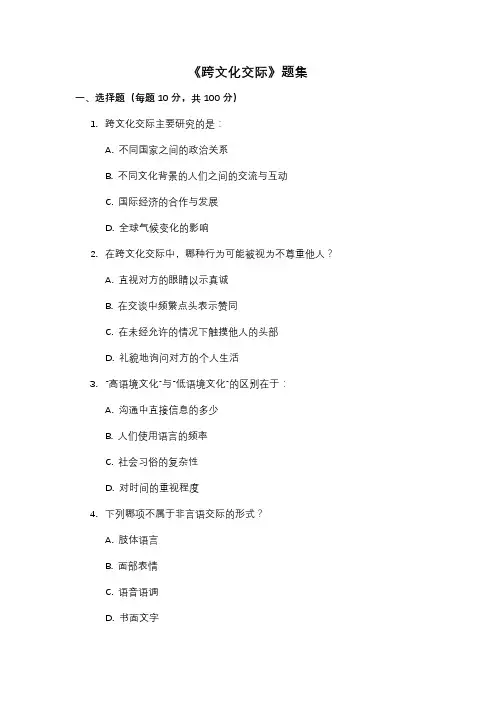
《跨文化交际》题集一、选择题(每题10分,共100分)1.跨文化交际主要研究的是:A. 不同国家之间的政治关系B. 不同文化背景的人们之间的交流与互动C. 国际经济的合作与发展D. 全球气候变化的影响2.在跨文化交际中,哪种行为可能被视为不尊重他人?A. 直视对方的眼睛以示真诚B. 在交谈中频繁点头表示赞同C. 在未经允许的情况下触摸他人的头部D. 礼貌地询问对方的个人生活3.“高语境文化”与“低语境文化”的区别在于:A. 沟通中直接信息的多少B. 人们使用语言的频率C. 社会习俗的复杂性D. 对时间的重视程度4.下列哪项不属于非言语交际的形式?A. 肢体语言B. 面部表情C. 语音语调D. 书面文字5.在一些文化中,沉默可能被视为:A. 同意的标志B. 思考的表示C. 不尊重的行为D. 沟通的一种方式6.“文化休克”通常发生在:A. 一个人长时间处于自己的文化中B. 一个人初次接触并适应新的文化环境时C. 一个人对某种文化有深入了解之后D. 一个人在不同文化之间频繁切换时7.下列哪项是跨文化交际中常见的挑战?A. 语言障碍B. 价值观差异C. 沟通风格的不同D. 以上都是8.在一些文化中,时间被视为一种:A. 可以随意支配的资源B. 必须严格遵守的规则C. 可以用来建立社会关系的工具D. 以上都有可能是,取决于具体的文化9.“面子”在跨文化交际中是一个重要的概念,它通常指的是:A. 一个人的社会地位B. 一个人的自尊心和荣誉感C. 一个人在外貌上的吸引力D. 一个人在经济上的实力10.下列哪项不是促进跨文化交际有效性的策略?A. 增强文化意识B. 发展跨文化沟通技巧C. 避免与不同文化背景的人交往D. 尊重并适应不同的文化习俗二、填空题(每题10分,共50分)1.在跨文化交际中,__________是指由于文化差异而导致的沟通障碍或误解。
2.__________文化强调直接、明确的沟通方式,而__________文化则更注重含蓄和间接的表达。

跨文化交际中的障碍与解决在全球化迅速发展的今天,跨文化交际变得越来越普遍。
然而,由于各国文化的差异,跨文化交际中常常会出现各种障碍。
这些障碍使得沟通的效率降低,有时甚至会引发误解和冲突。
本文将探讨跨文化交际中的主要障碍及其解决方法。
一、跨文化交际障碍的类型1. 语言障碍语言是文化的载体,跨文化交际中的语言障碍主要体现在: - 词汇差异:不同文化中某些词汇和表达的意义可能截然不同。
- 语法结构:不同语言的语法结构差异会导致理解上的障碍。
- 发音问题:非母语者的发音可能会影响对方的理解。
2. 非语言沟通障碍非语言沟通包括肢体语言、面部表情、眼神交流等,不同文化对这些非语言信号的解读存在差异。
例如: - 手势的理解:某些手势在一国可能表示友好,而在另一国可能被视为冒犯。
- 空间距离:不同文化对人际距离的接受程度不同,可能在交流中造成不适。
3. 文化背景障碍文化背景的差异造成了对事情的理解和反应的不同: - 价值观差异:不同文化有不同的价值观,如个人主义和集体主义的差异。
- 习俗与传统:各国的庆祝活动、礼仪等传统习俗也会影响沟通的流畅性。
4. 心理障碍由于对其他文化的误解和偏见,跨文化交际中可能产生心理障碍。
例如: - 刻板印象:对某一文化的片面看法可能导致误解。
- 不安全感:在陌生文化面前,个体可能会感到不自信和焦虑。
二、解决跨文化交际障碍的方法1. 提高语言能力•学习当地语言:掌握基本的语言交流能力可以降低语言障碍。
•使用简单明了的语言:避免使用复杂的术语和俚语,尽量简化表达。
2. 理解非语言信号•研究非语言沟通:了解不同文化对非语言信号的解读,减少误解。
•注意自己的肢体语言:在跨文化交际中,保持开放的姿态和友好的面部表情。
3. 增强文化意识•文化学习:通过阅读、参加文化交流活动等方式,深入了解其他文化的习俗和价值观。
•尊重差异:在沟通中保持开放的心态,尊重文化差异,共同寻找理解的基础。
4. 改善心理素质•克服刻板印象:通过交流和接触,消除对其他文化的刻板印象,形成真实的理解。
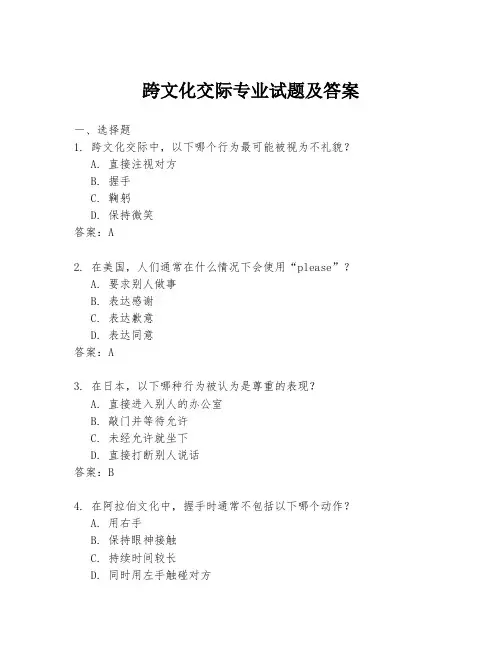
跨文化交际专业试题及答案一、选择题1. 跨文化交际中,以下哪个行为最可能被视为不礼貌?A. 直接注视对方B. 握手C. 鞠躬D. 保持微笑答案:A2. 在美国,人们通常在什么情况下会使用“please”?A. 要求别人做事B. 表达感谢C. 表达歉意D. 表达同意答案:A3. 在日本,以下哪种行为被认为是尊重的表现?A. 直接进入别人的办公室B. 敲门并等待允许C. 未经允许就坐下D. 直接打断别人说话答案:B4. 在阿拉伯文化中,握手时通常不包括以下哪个动作?A. 用右手B. 保持眼神接触C. 持续时间较长D. 同时用左手触碰对方答案:D5. 在中国文化中,赠送礼物时以下哪个行为是不恰当的?A. 包装礼物B. 赠送钟表C. 赠送书籍D. 赠送鲜花答案:B二、简答题1. 描述跨文化交际中非言语交流的重要性。
答案:非言语交流在跨文化交际中起着至关重要的作用,因为它可以传达情感、态度和文化背景。
非言语交流包括肢体语言、面部表情、眼神交流、声音的音调和节奏等。
不同的文化对这些非言语信号有不同的解读,因此理解和正确使用非言语交流对于跨文化沟通的成功至关重要。
2. 解释文化冲击是什么,并给出一个例子。
答案:文化冲击是指一个人在进入一个新文化环境时,由于文化差异而经历的心理和情感上的困惑、焦虑和不适。
例如,一个习惯于个人主义文化的西方人,当他第一次来到一个强调集体主义的亚洲国家时,可能会对那里的团队合作和群体决策感到不适应,从而经历文化冲击。
三、论述题1. 论述在国际商务环境中,了解和尊重不同文化的重要性。
答案:在国际商务环境中,了解和尊重不同文化对于建立和维护商业关系至关重要。
首先,了解不同文化可以帮助我们更好地理解商业伙伴的行为和期望,从而避免误解和冲突。
其次,尊重文化差异可以展示我们的开放性和包容性,这有助于建立信任和尊重,是长期合作关系的基石。
此外,跨文化交际能力也是全球化时代商务人士的重要技能,能够帮助企业在多元文化市场中取得成功。
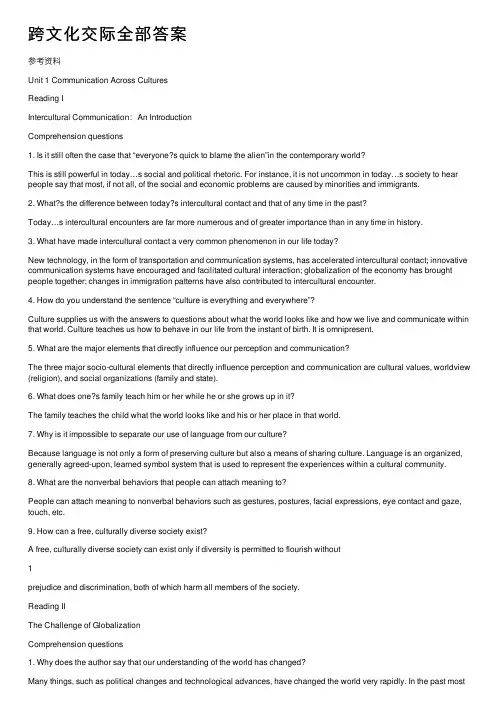
跨⽂化交际全部答案参考资料Unit 1 Communication Across CulturesReading IIntercultural Communication:An IntroductionComprehension questions1. Is it still often the case that “everyone?s quick to blame the alien”in the contemporary world?This is still powerful in today…s social and political rhetoric. For instance, it is not uncommon in today…s society to hear people say that most, if not all, of the social and economic problems are caused by minorities and immigrants.2. What?s the difference between today?s intercultural contact and that of any time in the past?Today…s intercultural encounters are far more numerous and of greater importance than in any time in history.3. What have made intercultural contact a very common phenomenon in our life today?New technology, in the form of transportation and communication systems, has accelerated intercultural contact; innovative communication systems have encouraged and facilitated cultural interaction; globalization of the economy has brought people together; changes in immigration patterns have also contributed to intercultural encounter.4. How do you understand the sentence “culture is everything and everywhere”?Culture supplies us with the answers to questions about what the world looks like and how we live and communicate within that world. Culture teaches us how to behave in our life from the instant of birth. It is omnipresent.5. What are the major elements that directly influence our perception and communication?The three major socio-cultural elements that directly influence perception and communication are cultural values, worldview (religion), and social organizations (family and state).6. What does one?s family teach him or her while he or she grows up in it?The family teaches the child what the world looks like and his or her place in that world.7. Why is it impossible to separate our use of language from our culture?Because language is not only a form of preserving culture but also a means of sharing culture. Language is an organized, generally agreed-upon, learned symbol system that is used to represent the experiences within a cultural community.8. What are the nonverbal behaviors that people can attach meaning to?People can attach meaning to nonverbal behaviors such as gestures, postures, facial expressions, eye contact and gaze, touch, etc.9. How can a free, culturally diverse society exist?A free, culturally diverse society can exist only if diversity is permitted to flourish without1prejudice and discrimination, both of which harm all members of the society.Reading IIThe Challenge of GlobalizationComprehension questions1. Why does the author say that our understanding of the world has changed?Many things, such as political changes and technological advances, have changed the world very rapidly. In the past mosthuman beings were born, lived, and died within a limited geographical area, never encountering people of other cultural backgrounds. Such an existence, however, no longer prevails in the world. Thus, all people are faced with the challenge of understanding this changed and still fast changing world in which we live.2. What a “global village”is like?As our world shrinks and its inhabitants become interdependent, people from remote cultures increasingly come into contact on a daily basis. In a ―global village‖, members of once isolated groups of people have to communicate with members of other cultural groups. Those people may live thousands of miles away or right next door to each other.3. What is considered as the major driving force of the post-1945 globalization?Technology, particularly telecommunications and computers are considered to be the major driving force.4. What does the author mean by saying that “the …global?may be more local than the …local?”?The increasing global mobility of people and the impact of new electronic media on human communications make the world seem smaller. We may communicate more with people of other countries than with our neighbors, and we may be more informed of the international events than of thelocal events. In this sense, ―the ?global…may be more local than the ?local…‖.5. Why is it important for businesspeople to know diverse cultures in the world?Effective communication may be the most important competitive advantage that firms have to meet diverse customer needs on a global basis. Succeeding in the global market today requires the ability to communicate sensitively with people from other cultures, a sensitivity that is based on an understanding of cross-cultural differences.6. What are the serious problems that countries throughout the world are confronted with?Countries throughout the world are confronted with serious problems such as volatile international economy, shrinking resources, mounting environmental contamination, and epidemics that know no boundaries.7. What implications can we draw from the case of Michael Fay?This case shows that in a world of international interdependence, the ability to understand and communicate effectively with people from other cultures takes on extreme urgency. If we are unaware of the significant role culture plays in communication, we may place the blame for communication failure on people of other cultures.8. What attitudes are favored by the author towards globalization?Globalization, for better or for worse, has changed the world greatly. Whether we like it or not,2globalization is all but unstoppable. It is already here to stay. It is both a fact and an opportunity. The challenges are not insurmountable. Solutions exist, and are waiting to be identified and implemented. From a globalistic point of view, there is hope and faith in humanity.Translation纵观历史,我们可以清楚地看到,⼈们由于彼此所处地域、意识形态、容貌服饰和⾏为举⽌上存在的差异,⽽长久⽆法互相理解、⽆法和睦相处。
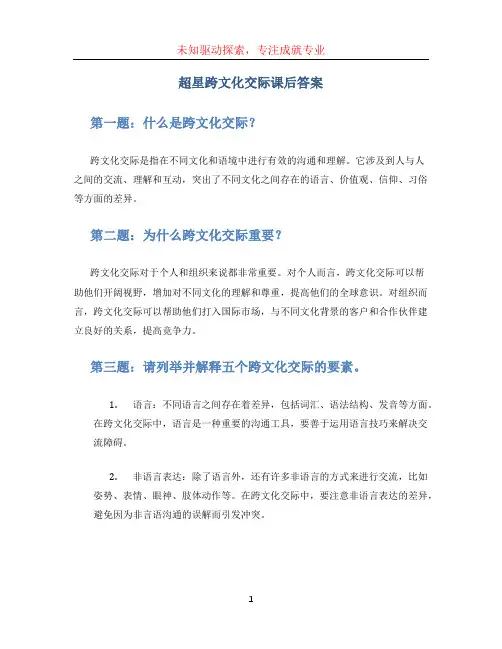
超星跨文化交际课后答案第一题:什么是跨文化交际?跨文化交际是指在不同文化和语境中进行有效的沟通和理解。
它涉及到人与人之间的交流、理解和互动,突出了不同文化之间存在的语言、价值观、信仰、习俗等方面的差异。
第二题:为什么跨文化交际重要?跨文化交际对于个人和组织来说都非常重要。
对个人而言,跨文化交际可以帮助他们开阔视野,增加对不同文化的理解和尊重,提高他们的全球意识。
对组织而言,跨文化交际可以帮助他们打入国际市场,与不同文化背景的客户和合作伙伴建立良好的关系,提高竞争力。
第三题:请列举并解释五个跨文化交际的要素。
1.语言:不同语言之间存在着差异,包括词汇、语法结构、发音等方面。
在跨文化交际中,语言是一种重要的沟通工具,要善于运用语言技巧来解决交流障碍。
2.非语言表达:除了语言外,还有许多非语言的方式来进行交流,比如姿势、表情、眼神、肢体动作等。
在跨文化交际中,要注意非语言表达的差异,避免因为非言语沟通的误解而引发冲突。
3.价值观:不同文化背景的人对于价值观的看法有所不同。
比如,对于一个文化来说,个人主义可能被强调,而对于另一个文化来说,集体主义可能更受重视。
了解不同文化的价值观差异,可以帮助我们更好地理解对方。
4.礼仪习俗:不同文化之间存在着各种不同的礼仪习俗。
比如,有些文化在见面时会握手,有些文化则会鞠躬。
了解并尊重对方的礼仪习俗,可以在交流中避免冲突和误解。
5.跨文化意识:跨文化意识是指对不同文化之间的差异和联系有充分的认识和敏锐的觉察。
它包括对自己文化的理解和认同,对其他文化的尊重和欣赏,以及在跨文化交际中灵活应对的能力。
第四题:列举并解释五个有效的跨文化交际策略。
1.学习对方的语言:学习对方的语言可以帮助我们更好地理解对方,并且可以展示我们对对方文化的尊重。
即使只是掌握一些简单的常用语,也能在交流中起到积极的作用。
2.尊重对方的差异:在跨文化交际中,我们应该尊重对方的差异,避免将自己的观念强加于对方。
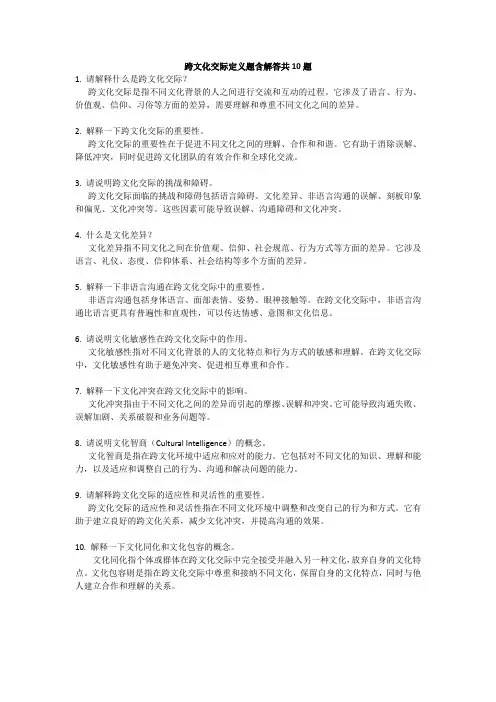
跨文化交际定义题含解答共10题1. 请解释什么是跨文化交际?跨文化交际是指不同文化背景的人之间进行交流和互动的过程。
它涉及了语言、行为、价值观、信仰、习俗等方面的差异,需要理解和尊重不同文化之间的差异。
2. 解释一下跨文化交际的重要性。
跨文化交际的重要性在于促进不同文化之间的理解、合作和和谐。
它有助于消除误解、降低冲突,同时促进跨文化团队的有效合作和全球化交流。
3. 请说明跨文化交际的挑战和障碍。
跨文化交际面临的挑战和障碍包括语言障碍、文化差异、非语言沟通的误解、刻板印象和偏见、文化冲突等。
这些因素可能导致误解、沟通障碍和文化冲突。
4. 什么是文化差异?文化差异指不同文化之间在价值观、信仰、社会规范、行为方式等方面的差异。
它涉及语言、礼仪、态度、信仰体系、社会结构等多个方面的差异。
5. 解释一下非语言沟通在跨文化交际中的重要性。
非语言沟通包括身体语言、面部表情、姿势、眼神接触等。
在跨文化交际中,非语言沟通比语言更具有普遍性和直观性,可以传达情感、意图和文化信息。
6. 请说明文化敏感性在跨文化交际中的作用。
文化敏感性指对不同文化背景的人的文化特点和行为方式的敏感和理解。
在跨文化交际中,文化敏感性有助于避免冲突、促进相互尊重和合作。
7. 解释一下文化冲突在跨文化交际中的影响。
文化冲突指由于不同文化之间的差异而引起的摩擦、误解和冲突。
它可能导致沟通失败、误解加剧、关系破裂和业务问题等。
8. 请说明文化智商(Cultural Intelligence)的概念。
文化智商是指在跨文化环境中适应和应对的能力。
它包括对不同文化的知识、理解和能力,以及适应和调整自己的行为、沟通和解决问题的能力。
9. 请解释跨文化交际的适应性和灵活性的重要性。
跨文化交际的适应性和灵活性指在不同文化环境中调整和改变自己的行为和方式。
它有助于建立良好的跨文化关系,减少文化冲突,并提高沟通的效果。
10. 解释一下文化同化和文化包容的概念。

跨文化交流考试试题及答案跨文化交流是现代社会中越来越重要的一个话题,随着全球化进程的加速,不同文化之间的交流与融合变得日益频繁。
为了帮助大家更好地了解和掌握跨文化交流的知识,本文将为大家提供一些跨文化交流考试的试题及答案,希望对大家的学习有所帮助。
试题一:简要解释什么是跨文化交流,列举出三种常见的跨文化交流挑战,并提出应对之策。
答案:跨文化交流是指不同文化背景的个体或群体之间进行沟通、交流和互动的过程。
在跨文化交流中,常见的挑战包括语言障碍、文化差异和价值观冲突。
为了应对这些挑战,可采取以下策略:学习对方的语言和文化,加强跨文化意识和能力,尊重和理解不同文化的差异,寻求共同点和共识,建立互信与尊重的关系。
试题二:简述跨文化沟通的要素及重要性,列举出三种有效的跨文化沟通技巧。
答案:跨文化沟通的要素包括语言、非语言表达、文化背景和社会习惯等。
跨文化沟通的重要性在于可以帮助个体或群体更好地理解和协调不同文化之间的关系,避免误解和冲突,提高合作效率。
有效的跨文化沟通技巧包括:尊重他人的文化与差异,保持开放与包容的心态,倾听和理解他人的观点,用简洁清晰的语言表达自己的意见,积极寻求共同目标。
试题三:描述一种跨文化交流的实际案例,分析其中出现的问题及解决方案。
答案:某公司在进行与国外客户的合作时,由于双方文化背景和工作习惯的不同,出现了沟通不畅、误解频发等问题。
为了解决这些问题,公司采取了以下措施:加强跨文化培训,培养员工的跨文化意识和能力;设立文化沟通专岗,担任文化中介的角色,协调双方的沟通;建立双向反馈机制,及时发现和解决问题。
通过以上试题及答案的介绍,相信大家对跨文化交流有了更深入的了解。
在现今社会,跨文化交流已成为一项非常重要的能力,希望大家能够通过学习不断提升自己的跨文化意识和能力,更好地适应和融入多元文化的环境中。
【总字数:448】。
跨文化交际试题及答案一、选择题(每题2分,共40分)1. 跨文化交际的定义是指:A. 不同国家和地区间的交际活动B. 不同民族和文化背景间的交际活动C. 同一文化内部的交际活动D. 不同语言之间的交际活动答案:B2. 文化差异会对跨文化交际产生以下哪种影响?A. 理解困难B. 语言障碍C. 价值观冲突D. 人际关系紧张答案:A、C3. 在跨文化交际中,以下哪种行为被认为是失礼的?A. 目光接触B. 握手问候C. 低头鞠躬D. 打招呼时用双手表示敬意答案:C4. 在中国文化中,以下哪种颜色象征喜庆和幸福?A. 黑色B. 红色C. 绿色D. 白色答案:B5. 在进行跨文化交际时,以下哪种策略是最有效的?A. 强调自己的文化优势B. 忽视文化差异C. 遵守对方的文化规范D. 强迫对方接受自己的文化观念答案:C二、简答题(每题10分,共30分)1. 请简要阐述跨文化交际的重要性以及其中存在的挑战。
答案:跨文化交际的重要性在于增进各国间的相互了解和友谊,推动跨国合作和发展。
然而,跨文化交际也面临着重重挑战,如语言沟通障碍、文化差异带来的不解和冲突,以及对他人观点和习俗的理解困难等。
2. 在国际商务谈判中,如何合理利用非语言交际手段?答案:在国际商务谈判中,非语言交际手段可以帮助加强沟通效果。
可以通过身体语言表达自信和诚意,比如坐姿、目光接触和手势运用等;可以通过服饰和礼仪来展示对对方文化的尊重;还可以通过图表和演示文稿等视觉媒介来辅助表达和说明。
3. 请简要解释文化冲突是如何产生的,并提出解决文化冲突的建议。
答案:文化冲突是由于不同文化之间的差异而产生的,当个体或群体面对不熟悉的文化规范和价值观时,可能会感到困惑和不满。
为解决文化冲突,建议应采取以下措施:学习和了解对方文化,加强跨文化交际能力;尊重差异,避免对他人价值观的评判和偏见;建立良好的沟通渠道,积极解释自己的观点并倾听对方的意见;寻求共同利益和双赢的解决方案。
跨文化交际期末试题及答案试题一:1. 跨文化交际的概念是什么?2. 跨文化交际中可能遇到的困难有哪些?如何应对?3. 请列举两个不同文化背景下的沟通误解,并说明产生误解的原因。
4. 如何加强跨文化交际的能力?5. 请描述一次成功的跨文化交际经历,并谈谈你从中学到了什么。
答案如下:1. 跨文化交际是指不同文化背景的个体之间进行信息传递和相互理解的过程。
它涉及到语言、行为、价值观等方面的差异,需要在尊重和理解对方文化的基础上进行有效交流。
2. 在跨文化交际中,可能遇到语言障碍、文化差异导致的误解、价值观冲突等困难。
要应对这些困难,首先需要学习对方的语言,尽量减少语言障碍。
其次,要了解对方文化的特点,避免由于文化差异而引起的误解。
最后,要保持开放心态,尊重不同的价值观,通过倾听和理解来解决潜在的冲突。
3. (1)例子一:在西方国家,直接表达意见被视为开放和直率的表现,但在东方文化中,过于直接的表达会被视为冒犯和不尊重他人。
这种差异可能导致沟通中的误解和冲突。
原因:西方文化注重个人主义和直接表达,而东方文化注重集体主义和含蓄表达。
双方的价值观和文化习惯差异导致了沟通误解。
(2)例子二:在某些非洲国家,左手被视为不洁之手,不可用于触摸或传递物品;而在西方国家,左手并没有特殊的意义。
如果一个西方人无意中用左手递给非洲人物品,可能会被视为不尊重对方的文化。
原因:非洲文化中,左手被认为是不洁的,使用左手被视为不尊重和不礼貌的行为。
而在西方文化中,没有类似的禁忌。
4. 加强跨文化交际的能力需要多方面的努力。
首先,要增加对不同文化背景的了解,包括语言、历史、价值观等方面。
其次,要培养跨文化沟通的敏感性和意识,学会观察和尊重不同文化之间的差异。
此外,多与来自不同文化的人交流,积累经验和技巧,不断提升自己的跨文化交际水平。
5. 描述一次成功的跨文化交际经历,得以学习到很多。
我在一次国际研讨会上结识了一位来自日本的研究者。
跨文化交际中的语言难题与解决方法跨文化交际是指在不同文化背景下交流和互动的过程,这种交流涉及到不同的语言、价值观、信仰和行为方式等因素,其中语言难题是跨文化交际中最重要、最直接的问题之一。
语言难题可能包括口音、语法、词汇差异、语言习惯等等。
在本文中,我们将会探讨跨文化交际中的语言难题以及如何解决这些问题。
一、口音问题口音是指特定地区或国家语言使用者的语音特征。
不同地区或国家的人在各自的语音习惯中,会使用不同的语音、语调、声音等方式来表达相同的意思。
这就会导致在跨文化交际中口音的问题。
要解决这个问题,我们可以采取一下措施:1. 提高听力听力是跨文化交际中最重要的技能之一。
如果你能够听懂其他人说的话,即使他们的口音很重,你也能够理解他们的意思。
因此,提高听力能力是解决口音问题的第一步。
2.增加对口音的了解通过学习其他人的口音,可以更好的理解他们的说话方式。
可以通过观看相关文化节目、电影、电视剧等来更好的了解别人的语音习惯。
3. 学习标准发音学习标准的语音是解决口音问题的重要措施之一。
通过学习标准语音,可以更加清晰地表达自己的想法,也可以更好的理解其他人的意思。
二、语法问题语法问题通常是指不同语言的句式、语序和语态差异。
不同语言之间由于文化和历史差异,语法上的不同会导致跨文化交际时出现语法问题。
解决这个问题的方法如下:1. 学习别人的语法结构学习别人的语法结构,可以帮助你更好的理解他们的表达目的和意图。
可以通过阅读相关文化资料来了解别人的语法结构。
2. 使用简单的语法结构使用简单的语法结构可以减少语法问题的出现。
在跨文化交际中,如果使用简短、简单的句子和语言结构,可以让人更容易了解你的意思。
3. 请人纠正请他人纠正自己的语法错误,是解决语法问题的简单有效的方法之一。
可以请他人纠正他们的错误,也可向他人请教自己的语法问题。
三、词汇问题不同文化和语言之间的词汇的使用会存在差异,这会导致跨文化交际时出现词汇问题。
跨⽂化交际问题1.What are the four trends that lead to the development of the global village? ①Convenient transportation systems; ②innovative communication systems; ③open market; ④widespread migrations.2.What are the three aspects where the cultural differences exist? Verbal; nonverbal;value3.What are the three ingredients of culture? ①Produce;②behaving;③concepts(belief, values, world views…)4.How to understand cultural iceberg? 冰⾯上:①visible;②tangible;③tip oficeberg;④easy to change. 冰⾯下: ①invisible;②intangible;③majority;④resistible(to change).5.* What are the characteristic of culture? Culture is learned; dynamic; ethnocentric;shared.6.* What are the characteristic of communication? Communication is dynamic;irreversible; symbol; transactional; systematic; contextual.7.What are three basic aspects of communication? And on what is important? ①Our individual personality,②the culture we operate in,③and the physical environment that surrounds us.8.How is Chinese addressing different from American addressing? ①In Chinesethe surname comes first and is followed by given name, but in English this isorder is reversed.②In recent years, many English-speaking people tend to address others by their given names, while Chinese used full name to address each other.③The Chinese custom of addressing each other with kinship terms, should not becarried over into English.④In English, only a few occupations or titles are used such as Doctor,Judge, Governor, Mayor, Professor, Nurse and rank in the armed forces like Captain.9.Who should be introduced first in the West? Female; guest; senior10.How is Chinese hospitality different from American hospitality? In Chinese, theprinciple of avoiding bringing trouble; in American, in contrast, it’s the host who tries to avoid interfering in guests’ freedom of action by learning room for the guest to make choices.11.How would Americans misunderstand the Chinese responses to the compliments?①In the first case, the implication wad that American woman had poor judgement.②In the second one, the hostess was not sincere. ③The Chinese would besuspected of “fishing for compliments”.12.Why are the Chinese reluctant to pay the compliments? ①It would most likelybe taken as a kind of flirtation.②People are cautious about drawing a line between compliment and flattery—an act which is considered very low and mean among the Chinese people.③Between a compliment and a positive subtle form of request.13.How is the Chinese different from American in expressing gratitude? ①Chinesepeople don’t usually say “thank you” to those who are very close and who are in a lower position. Saying “thank you”is very common in America, so they thank people all day long. ②Traditional Chinese customs don’t require people to express thanks for the small favors that others have done them. In contract, theAmericans would thank you all the way for very small and most ordinary things. 14.*What are the social functions of compliments? ①creating or reinforcingsolidarity, ②greeting people, ③expressing thanks, ④congratulation, ⑤encouraging people, ⑥softening criticism, ⑦starting a conversation, ⑧even overcoming embarrassment.15.*What are the 4 major verbal differences between Chinese and English? ①aterm in one language doesn’t necessarily have a counterpart in the other language;②Words or terms in both languages appear to refer to the same object or conceptonly on the surface, but actually refer to quite different things; ③things or concepts are represented by one or perhaps two terms in one language, but by many terms in the other language, i.e. finer distinctions exist in the other language;④terms have more or less the same primary meaning, but have secondary oradditional meanings that may differ considerable from each other.16.How is the Chinese writing style different from the American style?In Chinese,some oriental writing is marked by what may be called an approach by indirection.English native speakers express their thoughts with facts concerning the main topic. When they express certain ideas or concepts, they usually illustrate the concrete argument one step after another at distinct levels, and the argument are gradually unfolded with logic.17.What are the different features of M-time and P-time? M-time is noted for itsemphasis on schedules, segmentation and promptness. It features one event at a time. M-time cultures place great emphasis on schedules. P-time practiced by most other peoples is less rigid and clock-bound. People from P-time cultures schedule several activities at the same time, and time for them is more flexible and more human-centered.18.What are contrasting world views can be drawn from Buddhism and Christianity?Christiansen sees each one wad born with sins and therefore we should salvage ourselves. The salvation of the individual is achieved through hard work and piety.Christianity recognizes the importance of work and free ownership of property.Buddhists believe that there is a supreme and wonderful truth that the universe runs based on a dynamic balance. Buddhists don’t attach themselves to the impermanent objects and the pursuit of material well-being. Thus, little support is accorded to free enterprise.19.What are the American and Chinese cultural values like in terms of ValueOrientation put forward by Kluckhohn and Strodtbeck? American culture: ①human nature is evil but perfectible; ②man can master nature; ③future orientation; ④doing leads to external achievements; ⑤Individual: self is more important than group. Chinese culture: ①good but corruptible; ②harmony with nature; ③past orientation; ④being and becoming is a kind of spiritual good of inner harmony and peace; ⑤Group: in cultures with group values, people make decisions by consensus.20.Identify the features of each of four Hofstede’s cultural dimensions to the caseanalysis. ①Individualism VS collectivism ; ②hierarchy(层级) VS equality;③stability(稳定性) VS risk-taking(勇于冒险); ④masculinity(男性:assertiveness魄⼒,⾃信; competition; material实质性的success) VS femininity(⼥性: quality of life; interpersonal relationships ⼈际关系; concern for the weak对弱者同情)21.Identify the contrast between high-context and low-context culture and then it tointerpret the differences between American and Japanese or Chinese negotiating style? 东⽅---high context:While interpersonal communication in the Eastern culture resides primarily in the subtle, implicit, nonverbal, contextual realm and is understood intuitively. 西⽅--- low context: The Western communication mode is primarily direct, explicit, and verbal, relying heavily on logical and rational perception, thinking, and articulation.22.How is gender different from se x?23.What has influenced the gender socialization?。
跨文化交际中的沟通问题与解决方案在当今全球化的时代,跨文化交际已经成为日常生活中的常态。
不同文化之间的交流和沟通,常常面临着各种各样的问题。
本文将探讨跨文化交际中的沟通问题,并提出一些解决方案。
一、语言障碍语言障碍是跨文化交际中最常见的问题之一。
不同国家和地区使用不同的语言,语言之间的差异导致了沟通的困难。
例如,英语是全球通用的语言,但不同国家的英语口音和词汇使用可能存在差异,这给交流带来了一定的障碍。
解决方案:1. 学习对方的语言:学习对方的语言是最直接的解决方法。
通过学习对方的语言,可以更好地理解和表达自己的意思。
2. 使用简单明了的语言:避免使用复杂的词汇和句子结构,使用简单明了的语言可以提高交流的效果。
3. 多使用非语言交流方式:除了语言,还可以通过肢体语言、表情和姿势等非语言方式进行交流,这样可以更直观地传达信息。
二、文化差异文化差异是跨文化交际中另一个重要的问题。
不同的文化有不同的价值观、信仰和行为规范,这些差异会导致误解和冲突。
解决方案:1. 尊重对方的文化:了解对方的文化背景,尊重对方的价值观和行为规范,避免对对方的文化进行武断评价。
2. 建立文化共识:在交流过程中,寻找共同的价值观和行为准则,建立文化共识,以促进更好的理解和合作。
3. 学习跨文化交际技巧:学习跨文化交际的技巧和方法,如适当的礼貌用语、交际礼仪等,可以帮助我们更好地应对文化差异。
三、非语言交流问题非语言交流是跨文化交际中一个容易被忽视的问题。
不同文化之间的肢体语言、表情和姿势等非语言信号的解读可能存在误差,导致交流的不准确。
解决方案:1. 学习对方的非语言信号:了解对方的非语言信号的含义和用法,可以更准确地理解对方的意思。
2. 注意自己的非语言表达:注意自己的肢体语言、表情和姿势等非语言信号的表达,避免给对方造成误解。
3. 多注意观察和倾听:在交流过程中,多观察对方的非语言信号,倾听对方的言外之意,以更好地理解对方的意思。
1. What are the reasons which might contribute to an increase of intercultural contacts in the world?Nowadays, the increasing trend of intercultural contacts can be ascribed to four main factors: the advancement of technology, immigration, economic globalization and the emergence of multiculturalism.A. With the development of technology, the transportation systems and communication systems have witnessed great advancement. Trips once taking days are now measured in hours, making it possible for people to go to anywhere of the world in one day, and thus speeding up intercultural contact. Moreover, the advanced communication technologies, such as Internet, mobile phones and cable TV transmission equipment, have give people access to sharing and exchanging information and ideas instantaneously.B. Changes in population migration have also contributed to the development of increasing intercultural contact. Pursuing a better job or endeavoring for a better life, people from all over the world leave their country while bringing their own culture, habits, language and so on to the other.C. Economic globalization is another factor for increasing intercultural contacts. With the accelerated trend of economic globalization, the world we lived in is more and more i nterdependent and interrelated. And each country’s economy is tied to the economy of other countries. Therefore, the intercultural contacts between regions, countries and continents are inevitably increased.D. Multiculturalism is the view that the various cultures in a society merit equal respect and scholarly interest, describing the coexistence of many cultures in alocality, without any one culture dominating the region. Therefore, with the increasing of the trends of multiculturalism, the communications between regions and cultures will inevitably strengthened and increased.2. What are characteristic of communication and culture common to all human beings?Although communications are different from one another in their forms and norms, all communication systems around the world share certain characteristics.A. Indirect: one characteristic of communication is that people can only obtain messages from other’s words and behaviors instead of obtaining from the mind of others.B. Interactive: Communication takes place between at least two individuals, and each one in a communication process will affect or be affected by the other’s words or behaviors, and as a consequence, he/she will immediately modify or alter his/her responses either in words, tones, gestures, and so on.C. Dynamic: as all communication processes and their consequences are affected by the specific time, place, occasion and the number of people with their particular rules, values, customs, and so on, the communication can be perceived as an ongoing and ever-changing activity.D. Self-reflective: as human beings have a unique ability to think about themselves, to watch how they define the world, and to reflect on their past, present, and future, all forms of communication will inevitably involve and enhance this kind of activity, and thus endowed itself the self-reflective nature.Cultures, like communication, vary according to different history, geography, religion and world views, but they still share certain features.A. Invisible: as we refer to a certain culture, we often mean the world views, perceptions, values, attitudes and preference beneath all the phenomena in that culture, which are all intangible object to human beings.B. Learned: culture is not a procession that we inherited from out parents or forefathers, but is gradually acquired after birth by the influence of the traditional patterns and standards in the community we living.C. Ethnocentric: Each culture has its religion, myth and legends which convince every generation that they are special, powerful and intelligent and are thus capable of great achievements. Such pride helps to bind people in a society together to strive for ever greater accomplishments.D. Integrated: Culture is a complex and inclusive system in which all components, such as values, norms, perceptions and rules, are interrelated. And any change in one aspect of the culture will affect many other aspects.3. How are culture and language related to each other?A. Language is a guide to social reality. Language does not merely serve to allow us to describe what we see as reality, but language also shapes the way we see this reality.B. Language can record cultureLanguage can record the development of a society. People can learn culture left behind by their ancestors through language, and leave their culture to descendantsthrough language. For example, if we want to know the Chinese culture 1000 years ago, we can research the records of that time. Therefore through language, civilization passes over from generation to generation. The society will then make progress step by step.In fact, we can know other cultures by reading books. We don't need to go to go abroad to know about cultures of foreign countries. Language brings us convenience to learn different cultures.C. Culture affects languageFrom the definition of culture, we know that culture includes geography, religion, tradition, custom, value and so on. In fact, culture often affects language through them.Every nation lives and works in a certain natural environment, which is reflected by its language. People from different regions may have different languages. They use different words, metaphors to express their views towards their environment.Nearly every nation has its religion. Religion is an important part in culture. Many daily used words are from religion. For instance: Adam's apple (喉结); my rib(我妻); Judas's kiss(背叛)。
跨文化交际常见问题解答说明:下面是“跨文化交际”课程网上讨论中学生及教师常常提出的一些问题及中央电大主持教师的回复,供大家参考。
1. 怎样学好这门课?重点是中西文化对比及如何得体地交际。
2. 跨文化交际是不是就是了解各国的文化和风俗?That is part of the story. The real purpose is to learn how to communicate in that country.3. 英美国家概况对跨文化交际这门课有帮助吗?Sure! 英美国家概况中好多内容都和跨文化交际有联系。
4. 什么是跨文化交际?我学的是行政管理,我需要学吗?跨文化交际就是如果你和外国人打交道,应该注意什么问题,应该如何得体地去交流。
不管学的是什么专业,都应该学习一些这方面的知识。
5. 学习这科有什么好处?是否对我们进行交际有帮助?Absolutely yes. It will help you communicate appropriately.6. 跨文化交际的主要内涵是什么?中西文化差异及由此而来需要注意的交际技巧。
7. 跨文化交流这门课好学吗?怎样提高学习效率?Yes, if you work hard on it. 同时要制定一个切实可行的学习计划,然后坚持下去。
8. 我们学习此课程时需要什么参考书?导学、录音和录像。
9. 在学习该课之前我可以做些什么准备工作,使自己学得更好呢?可以看一些有关中西文化对比方面的中文书籍或刊物。
10. 关于这门课程能提供一些相关的英文网站吗?比如说非言语性交流、习语等知识的网站。
请浏览中央电大外语部的网站,通过电大在线进入,那里有许多相关链接。
11. How to translate “Culture Shock”? How to understand this problem?I am not sure how to translate Culture Shock into Chinese, but it means you are shocked or greatly surprised in a different culture. The reason is due to different traditions, customs, ways of thinking and doing things, etc.12. What can we gain in comparison of human communicative model and animal communicative model? Is it necessary?Yes, I think so. By studying animals, we can think of better ways of enhancing human communication.13. Now are there any changes in communication between men and women? Is it a trend for women to be dominant in communication?In China it is. In the West, it depends on whether the lady is a leader or boss. If she is, she is dominant in communication.14. Is the pattern of making friends different in China and in the West? What are the differences?The way we treat friends is different. A typical example is: when you eat out with friends in the West, you will split the bills. This is quite rare in China.15. Is non-verbal communication limited to gestures, facial expression, eye contact and space? Are there any others?I think they are the major ones. Generally, non-verbal communication refers to body language.16. Are there any relations between situational schema and communicative behavior?Yes, there are. We have different behaviors in different situations.17. We must do good rather than evil on however humble a scale. 这句话如何理解?不以善小而不为,不以恶小而为之。
18. Please talk about the characteristics of culture.Culture has a shared background (e.g. national, ethnic, religious) resulting from a common language and communication style, customs, beliefs, attitudes, and values. It refers to the informal and often hidden patterns of human interactions, expressions, and viewpoints that people in one culture share.19. How to distinguish between cultural observation and cultural judgment?Judgment is based on observation. Observation is the pre-condition of making a judgment. They are different, but closely connected.20. 请问怎样区别男名和女名?There is a detailed explanation about the difference between male and female names in English on Page 122 in your textbook. Please read it carefully and then you will surely get an answer to your question. However, the safe way is to consult the dictionary when you are not sure.21. How to talk with foreigners? Are there some appropriate topics?It depends. When in cross-cultural communication, make sure of your own communicative purpose. If it is just a small talk, then some common topics, such as weather, travel, work andsports, will be appropriate. But if you intend to make further relationships, then try to find something in common between you and your foreign friend. What’s more, the better way is to introduce some interesting Chinese cultures in your conversation, for example, Chinese cuisine (food culture) and eating habits, typical Chinese ways of friendship, politeness, etc. All those are interesting topics that are exactly the main topics of our course. Our course tries to help you in how to make a successful intercultural communication. In conclusion, in addition to getting to know about other cultures, you should also learn how to introduce your own culture to the others. Remember, "give and take" always works well in every situation.22. I want to know how to use the idioms correctly. Can you give me some advice? When we communicate with others, we often don’t know their meaning. I don’t know how to do it well?Memorize the idioms first as you memorize new words, but better in a sentence, then try to use them in your assignments. Remember in formal writing, we do not use the oral idioms very often.23. 怎样处理不同文化背景下的语言表达形式?感知、体会、记忆。